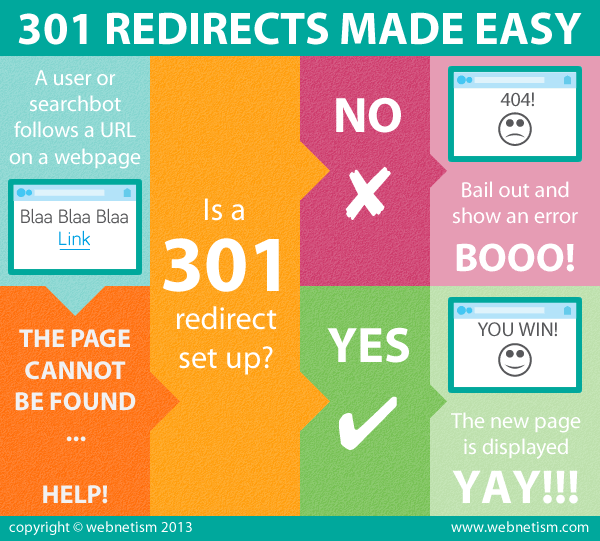301 redirects are permanent redirects from one website URL to another; they tell the client (the person viewing a site, or the system using a site [search engines, crawlers]) where to find content when they have requested a certain web page. The redirect itself is handled automatically so users don’t have to do anything.
As well has ensuring your users can find content they are looking for on your website, 301 redirects help maintain any SEO value or weight a page has on search engines. It does this by supplying the new location for that content. Effectively you’re letting clients know: “the content or web page that was here can now be found there”.
When should 301 redirects be used
Since it’s essentially a way of informing the client there has been a “change of address” you should consider using 301 redirects if:
- The location (URL) of a web page has changed
- The web page or content has been removed, and there’s a relevant alternative
- The web page has been replaced
- There are external websites linking to your website incorrectly and it’s easier to correct these requests with a 301 redirect.
- Links become outdated. For example, the structure of your website or your URLs may have changed because you’ve got a new website.

How to do 301 redirects
Hosting/server environments or programming languages (like ASP.NET or PHP) provide ways of using implementing 301 redirects. Unfortunately, in some cases these can be set up wrong, use outdated methods, or not produce redirects in the most effective way.
Our Cheltenham website development team have built a system that extends .NET functionality, integrates with our CMS:42 and plugs in to our error handling system. It can store and manage all your redirects. Any requests made to your website, whether it is for a specific web page, section or even a specific file can be handled by this 301 redirect system and efficiently redirect your users to the correct place on your website.
Is it important for SEO (Search Engine Optimisation)?
In short, yes. But it’s also very important for your users.
Broken links or poor external linking can mean you’re missing out on relevant views; these could be search engines indexing your site, or even users trying to browse your site.
Moved, deleted or replaced pages can mean any SEO value/weight that a page had could be lost. Using 301 redirects can help maintain this and provides an association between pages and content.
Having issues with SEO or 301 redirects, then get in touch.